Brown Kukri Snake
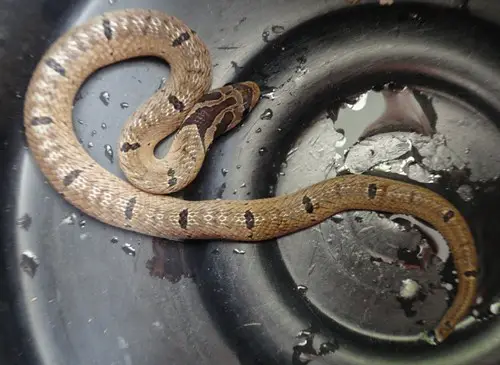
Oligodon purpurascens (Brown Kukri Snake)
Thais say: Ngoo koot
Appearance: Typical kukri shape – not long, but thick snakes with a short tail and no real separation between neck and head. Very small head. Pattern on top of head indicative of most kukri species. Venter is creme or pink.
Length: Average just under 1 meter (about 37 inches)
Range: All over Thailand. Brown Kukri snakes were once thought to be native to only the southernmost Thailand provinces, however J. Bulian has found one in Pattaya and there have been others discovered farther in the northeast. Assume the Brown Kukri’s habitat is across most of Thailand.
Habitat: These snakes prefer life in the forest and can be found at great elevations – about 1 mile high (1,600 meters). I have received numerous requests to identify this snake from readers who found them close to or inside their homes as well. The habitat is wide and varied for this species. Regardless where they are found, they enjoy living under brush, wood, rocks, and thick flora.
Active Time? Nocturnal, active at night and in the early morning as the sun rises. I have also found them in the middle of the day, and toward evening before sunset.
Food: Frogs, lizards, geckos, skinks, and their eggs.
Defensive Behavior: If the brown kukris are bothered enough they will roll their body to the side and lift up their tail – perhaps to present it as a place to attack – leaving the mouth free to strike when the aggressor does go for the tail. Kukri snakes have specialized egg-slicing teeth in the back of the jaw which are enlarged and shaped like a kukri knife. When held by the head, this snake can expertly twist the jaw around to stick the handler with these teeth. Holding is not recommended.
Venom Toxicity: No venom.
Offspring: Lay 6-12 eggs. A reader reported his snake had 8 eggs the first time and 10 the next. Eggs hatched after 60 days, incubated at 29 degrees C. Hatching in Bangkok latitude around late April.
Notes: Though this snake is not venomous, it is keen to bite and can inflict deep wounds due to it’s large, curved teeth and strong bite. Michael Cota, researcher, says, “Appears that it might be an evolutionary link on the way to being venomous, since it is the only snake that I can think of that has “fangs” (enlarged pair of teeth), but no venom delivery system or ducts to the teeth. They are not dangerous, but will give you quite a bloody bite that takes a long time to heal. What makes them so difficult is that their head is not distinct; therefore, it is extremely difficult to grab behind the head and keep proper control of it. It maneuvers it head around on your grip and then uses teeth to bite – slash.”
You’ll need a tetatus shot if you are bitten, as with all snakes as a precaution.
Kukris are common and you might see one in Thailand if you live here.
Brown Kukri Scientific classification
Kingdom: Animalia
Phylum: Chordata
Subphylum: Vertebrata
Class: Reptilia
Order: Squamata
Suborder: Serpentes
Family: Colubridae
Subfamily: Colubrinae
Genus: Oligodon
Species: Oligodon purpurascens
Binomial name: Oligodon purpurascens
Classified by Schlegel in 1837.
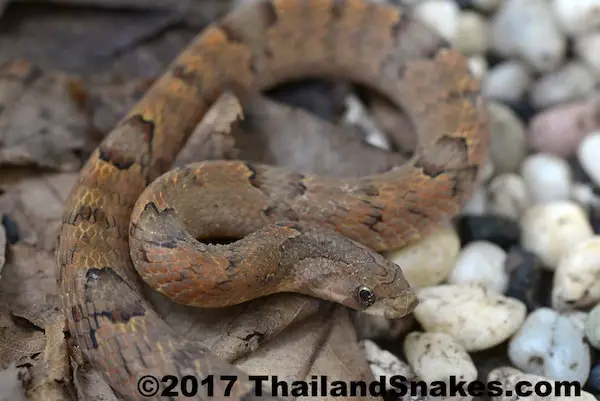
- Common Non-Venomous Snakes Post #1 Post #2
- Brahminy Blind Snake
- Brown Kukri Snake
- Copper-Headed Racer / Radiated Rat Snake | IndoChinese Rat Snake | Oriental Rat Snake / Banded | Red-Tailed Racer | Ridley’s Racer | White-Bellied Rat Snake
- Dragon Snake
- Laotian Wolf Snake
- Malayan Bridle Snake
- Orange-Bellied Snake
- Red-Tailed Pipe Snake
- Reticulated Python | Blood Python | Burmese Python
- Striped Bronzeback
- Sunbeam Snake

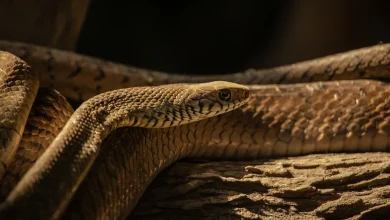
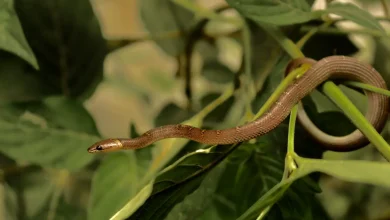
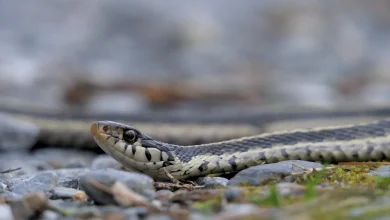
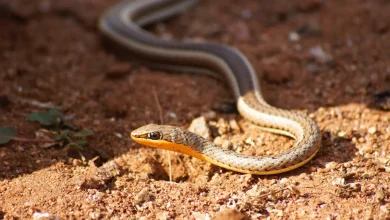
Hello Vern,
thank you very much for this useful info.
I live in Chiang Mai and it seems that today I caught a Kukri which is not aware about your post here or lost its way. Maybe it was on vacation in the North.
Mine was spotted by my dog swimming in a small pond in the afternoon, not in the evening. The pond is sourrounded by low grass and concrete, no thick flora around.
After I got it with a snake-catcher it showed perfect defensive behaviour as described in your post.
Tomorrow I will make some pictures, then release it somewhere further away into the green.
If you want some more pictures please send me a mail.
Best regards
Guido
Yes, great – I love to get photos of snakes. Send ’em if you got ’em! Cheers, Vern
I found two small snakes, one was very little indeed in my garden in Pattay this week. The look like that one, but still lighter. They had a very aggressive behaviour and I really got worried whether they might be little Malayan Vipers. I will try to send the picture I took of one of them (how could I send it?), which was found by our cat. The other one was under the lit of our water reservoir. When I lifted the lid it was just sitting there. I removed both out of y garden, but did not kill them.
Yes, Kukri snakes – I answered your email. Nice patterns on those. Cheers!
Hi Vern
Nice info about this great snake.
Regarding offspring, then i can informe you that they lay eggs, proberly around 6-12.
I have bread them twice now, and my first clutch was 8 eggs (7 hatched) and the second was 10 eggs (all hatched), they hatched after 60 days incubated at 29 degrees celcius.
I got a few pictures here http://www.nhf.dk/phpBB/viewtopic.php?f=3&t=43611 but the text is danish sry ;)
Thanks for the info – the pictures were great too. Cheers…
ohh and btw there main food source to my knowledge is eggs ;)
and there egg eating habbit is why they have those enlarged rear teeths, they use them to slice open eggs, put in there head in the cracks they made and drink the egg, also for this reason they can take much larger eggs than there african counterparts who swallow the eggs hole, and then crush them.
We live in Chiang Mai and have killed one (oops…thought it could be poisonous until I found this page) and saw another today under some brush in our garden. Seems they really do live up North – and are even out during the cold season!
Thanks for your great site. It is my number one resource for my snake FAQ here in Thailand!
Alina
Thanks for your comment Alina – much appreciated!